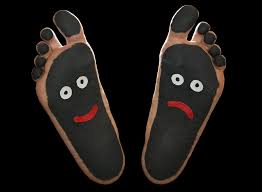3 December 2018
Country: The Netherlands
By Eline Jeanne

 Around this time of the year, Dutch children eagerly await the arrival of Sinterklaas (translated: Saint Nicholas) and Zwarte Piet (Black Piet) who travel to the Netherlands on a steamboat from Spain to slide down the chimney and deliver presents on Sinterklaas Eve for many children’s favorite holiday.
Around this time of the year, Dutch children eagerly await the arrival of Sinterklaas (translated: Saint Nicholas) and Zwarte Piet (Black Piet) who travel to the Netherlands on a steamboat from Spain to slide down the chimney and deliver presents on Sinterklaas Eve for many children’s favorite holiday.
It is a beloved celebration across the country, but there is a catch. Zwarte Piet—who, according to tradition, punishes naughty children and brings them back to Spain in a jute sack—is traditionally depicted as Black, complete with Moorish clothes with a big afro, full red lips and gold hoop earrings, traits that the European Network Against Racism (ENAR) says are universally agreed racist stereotypes and reinforce a problematic image of Black people as villains.
As a result, Black children, and other children of color, experience higher levels of bullying and discrimination around the holidays, a time that should be joyous for everyone. In a survey conducted by the children’s ombudsman in the Netherlands, Black children reported that some of their white peers had called them Zwarte Piet, and ordered them to serve them candy and presents. One child recounted his classmates calling him an “ape” and pelting him with Sinterklaas cookies.
After receiving complaints, the United Nations conducted a review of Black children’s experiences of Zwarte Piet, and concluded that many experience the character as a “vestige of slavery,” and its radicalized characteristics should be changed.
However, in recent years, the Geert Wilders’ far right PVV (Party for Freedom) political party has backed an increasingly militant pro-Zwarte Piet movement, which aims to crush the calls for Zwarte Piet’s character to evolve with the changing times. While some argue that he is Black because he came down a chimney (and a white actor donning Blackface is simply portraying a character) others have ambushed anti-Zwarte Piet demonstrations with beer cans and eggs, and in the most extreme cases, greeted them with a Nazi salute.
Dutch Prime Minister Mark Rutte intervened, saying that everyone’s priority is to give children the magic of the Sinterklaas holiday. However, he misses an essential point: are all Dutch children really experiencing the magic of Sinterklaas, with Zwarte Piet staying the way he is?
As a white child, I did not have to think twice about the racist implications of Zwarte Piet. Every year, I took part in the “Zwarte Piet Academy” where we learned how to carry presents while climbing through makeshift chimneys in preparation for the holidays. As a teenager, I wanted to bring this experience to other children, and dressed up as Zwarte Piet—Blackface and red lipstick and all—for a Sinterklaas parade. It was only when I was sending pictures to friends that I started to feel uneasy, and pushed myself to research the character’s history, and began to question whether or not Zwarte Piet’s Blackness was essential to our traditions.
Public opinion is slowly changing. Now, 38 percent of the population supports changing Zwarte Piet’s characteristics—up from only seven percent as recently as 2011. One of the biggest causes of this is international media attention; the Independent ran an in-depth piece looking at the history of Zwarte Piet, and Al Jazeera interviewed the founders of an anti-Piet group. One of the most impactful pieces of journalism is a three minute video in which Dutch filmmaker Sunny Bergman films herself walking around London dressed as Zwarte Piet, showing how inappropriate the tradition is to a non-Dutch audience.
I am happy to say that my little brother recently participated in a Sinterklaas parade where he portrayed “Orange Piet” along with a range of different colored Piets. Everyone was still able to dress up, receive presents and enjoy the Sinterklaas sweets, but no element of our tradition was lost.
For me, this shows that Dutch citizens, it is not too late to put an end to a racist tradition, and ensure that all children can enjoy the magic of Sinterklaas Eve.